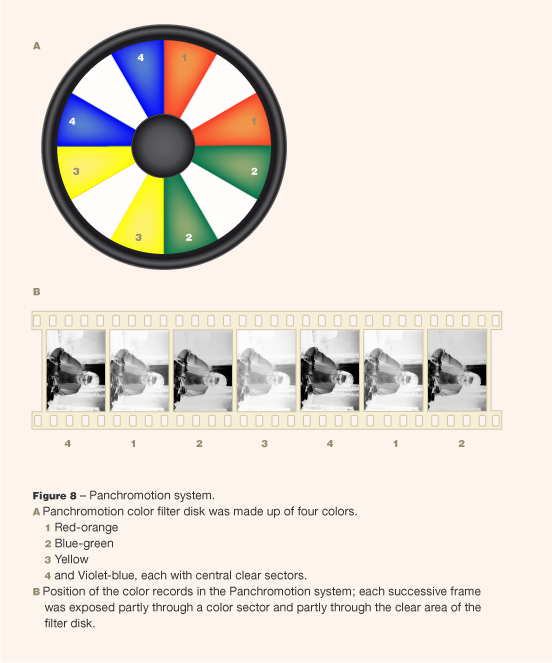-
![]() Credit: George Eastman House Motion Picture Department Collection. Film: The Old Family Toothbrush (USA 1925).
Credit: George Eastman House Motion Picture Department Collection. Film: The Old Family Toothbrush (USA 1925).
Select Category▼×
- All Categories
- Bibliography
- Chromogenic monopack
- Chromolytic multilayer
- Color separation
- Double-coated / bi-pack
- Edge Codes and Identification
- Hand coloring
- Other
- Printing / dye-transfer
- Printing / pigment process
- Screen processes
- Spatial synthesis (multiple lenses, beam splitter)
- Stencil coloring (pochoir, Pathécolor)
- Temporal synthesis (rotary filters)
- Theory
- Tinting
- Toning
“In 1919 Kelley produced a series of coloured cartoons which were drawn by Pinto Colvig. In 1924 he introduced “Kelleycolor,” which was an imbibition process. Two colours were imbibed on a black-and-white key image. In 1926 he ...
”Kelley’s first color process was a four-color additive system introduced in 1913. Called Panchromotion, Kelley formed a company which would exploit the process commercially and, he hoped, provide strong competition for Kinemacolor. He apparently ...
-
![]() Credit: Illustration by Sarah Steinbacher, Multimedia & E-Learning-Services, University of Zurich. Source: Ryan, Roderick T. (1977): A History of Motion Picture Color Technology. London: Focal Press.
Credit: Illustration by Sarah Steinbacher, Multimedia & E-Learning-Services, University of Zurich. Source: Ryan, Roderick T. (1977): A History of Motion Picture Color Technology. London: Focal Press.
- Source: Ryan, Roderick T. (1977): A History of Motion Picture Color Technology. London: Focal Press.
2 Images
“In its final form Prizma made use of duplitized positive film. As in previous Prizma systems, the original negatives were alternate frame sequential exposures. The Prizma negative was printed on both sides of the positive film in a special ...
-
![]() The two colors visible at a splice. Credit: EYE Film Institute Amsterdam. Film: [Kleurenpracht].
The two colors visible at a splice. Credit: EYE Film Institute Amsterdam. Film: [Kleurenpracht].
- Credit: George Eastman House. Preserved by Carole Fodor, Haghefilm Digitaal fellow and graduate of The L. Jeffrey Selznick School of Film Preservation. Film: A Day with John Burroughs (Prizma, 1919).
- Credit: George Eastman House. Preserved by Carole Fodor, Haghefilm Digitaal fellow and graduate of The L. Jeffrey Selznick School of Film Preservation. Film: A Day with John Burroughs (Prizma, 1919).
- Credit: George Eastman House Motion Picture Department Collection. Film: The Land of the Great Spirit (1919).
- Credit: Geo. Willeman, Nitrate Film Vault Manager, Library of Congress. Film: The Orange.
- Credit: Geo. Willeman, Nitrate Film Vault Manager, Library of Congress. Film: The Orange.
- Credit: Geo. Willeman, Nitrate Film Vault Manager, Library of Congress. Film: The Orange.
399 Images in 14 Galleries
“The color experiments were conducted in the basement of a house at 1586 E. Seventeenth St., Brooklyn, N. Y. During this time a double-coated stock and a bleach formula which had much to do with the success of the later Prizma process were ...
”The process as illustrated in USP 1431309 was a two-color additive process, but it is stated that it could be a three- or four-color process. For the original photography, the negative was exposed through a line screen composed of alternate bands ...
-
![]() Source: Ryan, Roderick T. (1977): A History of Motion Picture Color Technology. London: Focal Press.
Source: Ryan, Roderick T. (1977): A History of Motion Picture Color Technology. London: Focal Press.





